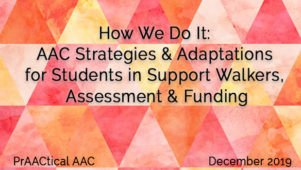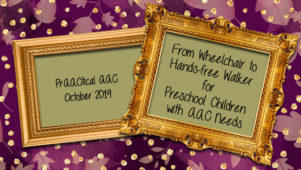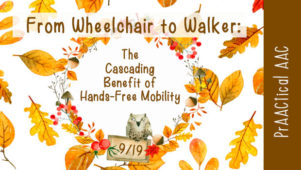How We Do It: A Support Walker Mobility Program for Elementary Students with AAC Needs
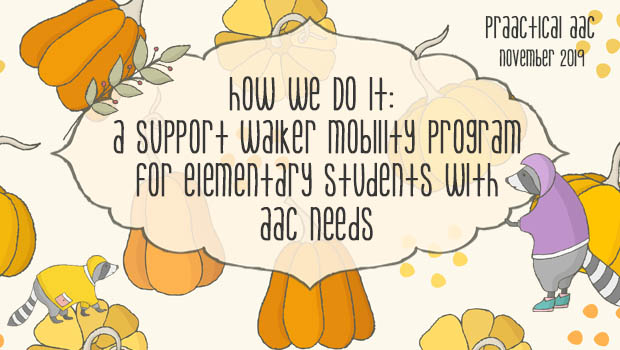
 We’re very pleased to welcome back Christine Wright-Ott to continue the series on supporting the independent mobility of children with AAC needs. Christine is an Occupational Therapy consultant at the Bridge School in northern California. She authored the chapter “Mobility” in the 4-7th editions of the book, Occupational Therapy for Children. She lectures at universities and conferences including ATIA, Closing the Gap, ISAAC, ISS, and AAC by the Bay. Today, she discusses the ways she and her colleagues help elementary school students use support walkers.
We’re very pleased to welcome back Christine Wright-Ott to continue the series on supporting the independent mobility of children with AAC needs. Christine is an Occupational Therapy consultant at the Bridge School in northern California. She authored the chapter “Mobility” in the 4-7th editions of the book, Occupational Therapy for Children. She lectures at universities and conferences including ATIA, Closing the Gap, ISAAC, ISS, and AAC by the Bay. Today, she discusses the ways she and her colleagues help elementary school students use support walkers.
You can read the first two installments of this series using the links below.
- Part 1: From Wheelchair to Walker: The Cascading Benefit of Hands-Free Mobility
- Part 2: From Wheelchair to Hands-free Walker for Preschool Children with AAC Needs
The Support Walker Mobility Program for Elementary Students with AAC needs
The second post in this series described the Preschool hands-free Support Walker Mobility Program developed at The Bridge School, which is a private school for preschool and elementary children with complex communication and physical disabilities located on the district’s public elementary school campus. I would like to share with you how we embed support walker mobility into the curricula for the elementary students at the Bridge School. Students use their support walkers for Mobility Math, field trips, inclusive physical education and daily during recess. The hands-free support walkers provide the students with access to highly motivating playground activities with peers (walking, running, jumping, playing hide and seek and kicking the ball in soccer), leading to meaningful and novel peer interactions. Such experiences have included selecting a peer for a race, walking down the runway with friend to model outfits during a Project Walkway fashion show, meeting friends who put stickers on the student’s shoes then parading around to show off their artwork and joining either the soccer line-up to practice kicking the ball or playing soccer on the playground with peers.
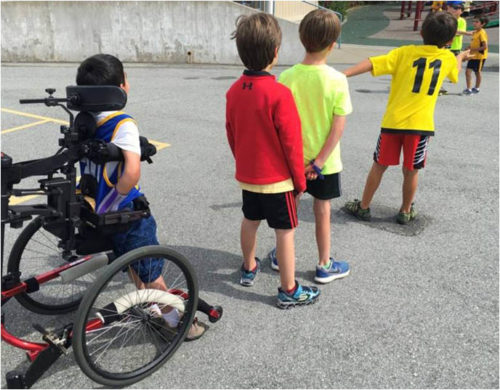
A student in his KidWalk at recess waits his turn to kick the soccer ball.
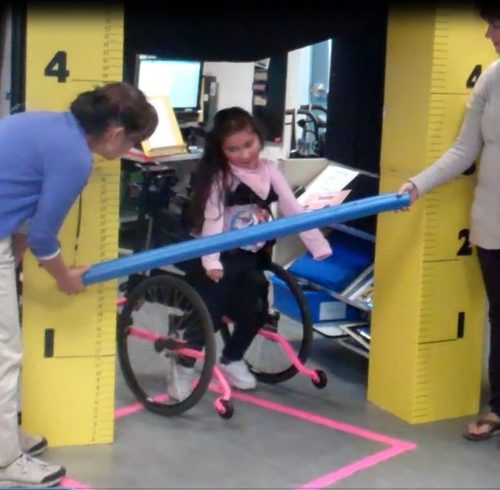
Mobility Math: students learn how tall they are while walking through a hand made a large ruler.
The Benefit of Recess for All Students
Recess is a crucial and necessary component of a child’s development. It’s an opportunity to take a break from academic instruction to run, jump, socialize with peers in an unstructured environment and to play games and sports like soccer and kickball. The American Academy of Pediatrics supports the belief that recess encourages unstructured play, imagination, problem-solving, movement, exercise and socializing with peers (Murray et al., 2016). Recess also provides a means for physical activity and exercise, an often undervalued benefit. Research has concluded that exercise and physical activity in typically developing children has been linked to an increase in academic performance, memory, and attention (Graham et. al., 2014.) Students assigned a daily schedule with more physical activity breaks outperformed their control-group peers in mathematics and reading (Tomporowski, 2016). Haapala et. al., (2014) concluded that physical activity at recess is positively associated with peer relationships at school. Therrien, Light, and Pope (2016) reviewed studies on improving the social interaction of children using AAC. They concluded that a physical disability negatively impacted social interaction intervention, possibly due to difficulty exploring and obtaining access to peers.
Access to Recess and Peers
Teachers have observed peers at recess being more engaged, at ease and willing to interact with students who use hands-free walkers, inviting them to play, giving fist bumps, praise, standing close by and talking to them, leading to more authentic and meaningful interactions. Support walkers provide students with more opportunities to exercise, play sports and participate in playground activities. Staff have observed students, who are pushed in wheelchairs at recess, who cannot run, jump, chase or kick a ball, demonstrate less physical and social interaction with their peers. These observations suggest that students with communication and physical disabilities, who have the opportunity to walk and run using hands-free support walkers, selected specifically to allow access to the environment, experience more opportunities for meaningful physical and social interaction with peers.

A peer gives this student in a walker high-five after he saw how far he kicked the soccer ball during a playground soccer game.

This student was so dependent on holding his handheld push walker, he never had an opportunity to learn to throw and catch a ball at recess. After practicing in a hands-free walker for 3 weeks, he learned to catch!
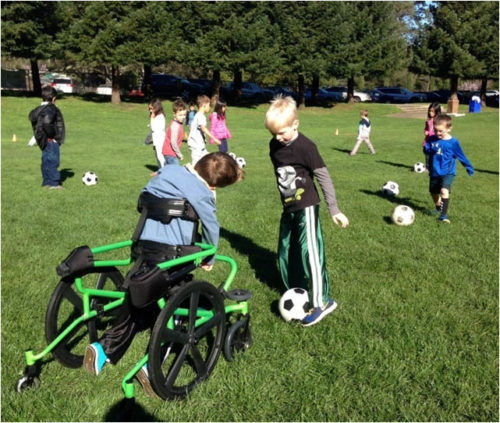
Using a ProneWalk in inclusive Physical Education. The large wheels are required for maneuvering over the field.
Summary
Recess is a critical element of the school day, contributing to a student’s academic, physical and social development. The Bridge School has embedded self-initiated mobility into the preschool and elementary curricula, including recess, through the provision of hands-free support walkers, which has improved opportunities for peer interaction and motivation of our students. Students with a physical disability, who are not offered the opportunity to walk, run, jump and use their legs and arms for playing and participating in games with peers, will be greatly disadvantaged. In the final post, AAC strategies, adaptations, assessment of support walker mobility and funding will be shared along with resources.
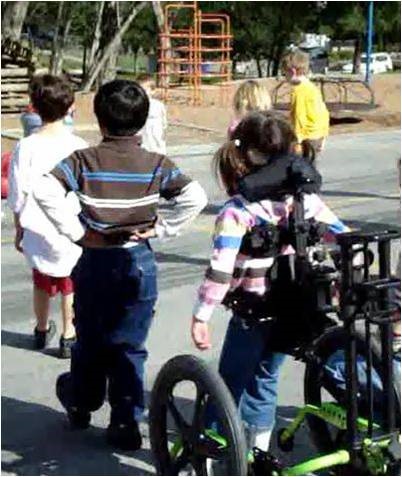
A student uses her KidWalk to participate in inclusive Physical Education.
Resources
Filed under: Featured Posts, PrAACtical Thinking
Tagged With: mobility, mobility impairment
This post was written by Carole Zangari

